For someone who has never taken a psychedelic drug it can be difficult to imagine what it’s like. You’ve probably heard of melting walls, tasting colors or kaleidoscopic vision.1 Such pronounced hallucinations are typically the outcome of high doses of LSD or psilocybin. In moderate doses, however, the effects are more subtle. Colors appear more vivid and patterns may morph slightly, but users usually don’t see things that aren’t actually there.
On TV and in movies, psychedelic experiences are often misrepresented or exaggerated. Looking for more realistic examples of common dose effects2 I found this photo depicting what someone might see while looking at an otherwise normal patch of grass.
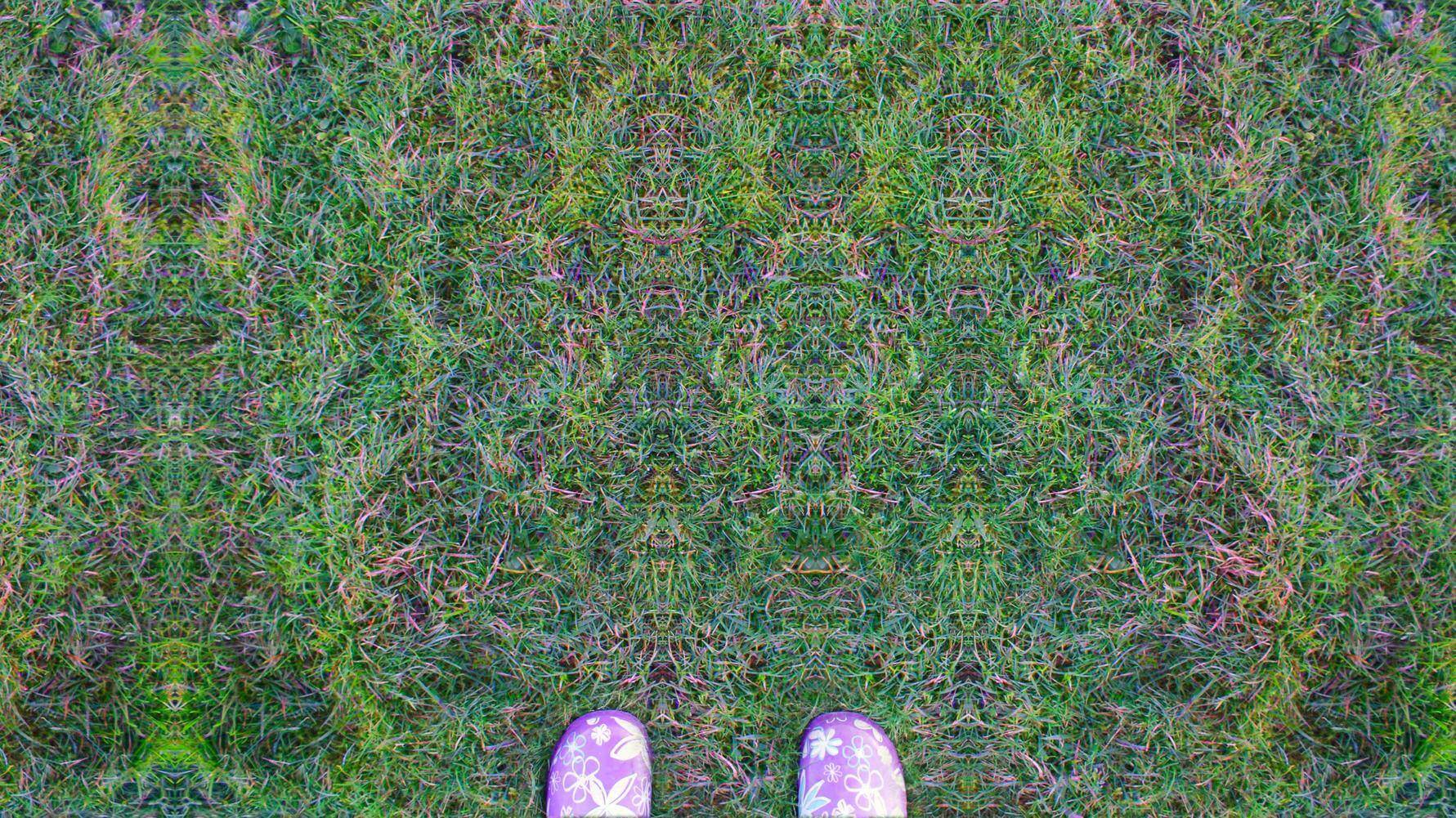 Hallucinogenic vision by Chelsea Morgan
Hallucinogenic vision by Chelsea Morgan
It’s still grass, but the colors are amplified and the individual blades of grass seem to compose geometric shapes, maybe you can even detect objects or faces.
The higher the dose, the more intense the hallucinations. The following image demonstrates a visual experience one may get from a slightly higher dose of LSD:
Visual acuity enhancement by StingrayZ
In any case, visual effects are just one aspect of the psychedelic experience. Psychedelic drugs create an altered state of consciousness that I like to describe as interpreting reality in a different way. Others have described it as seeing the world through the unbiased eyes of a child. But if you ask ten other people, you’ll get ten other answers. So, let’s hold the subjective descriptions aside for a moment and look at a quantified model of altered states of consciousness.
Measuring altered states of consciousness
In order to measure psychedelic experiences, researchers use a model called the five-dimensional altered states of consciousness rating scale (5D-ASC).3 Each psychedelic drug creates a unique signature on that scale. In the chart below I’ve combined data from several 5D-ASC studies4 in order to compare the psychedelic experience of MDMA, LSD, psilocybin and ketamine.
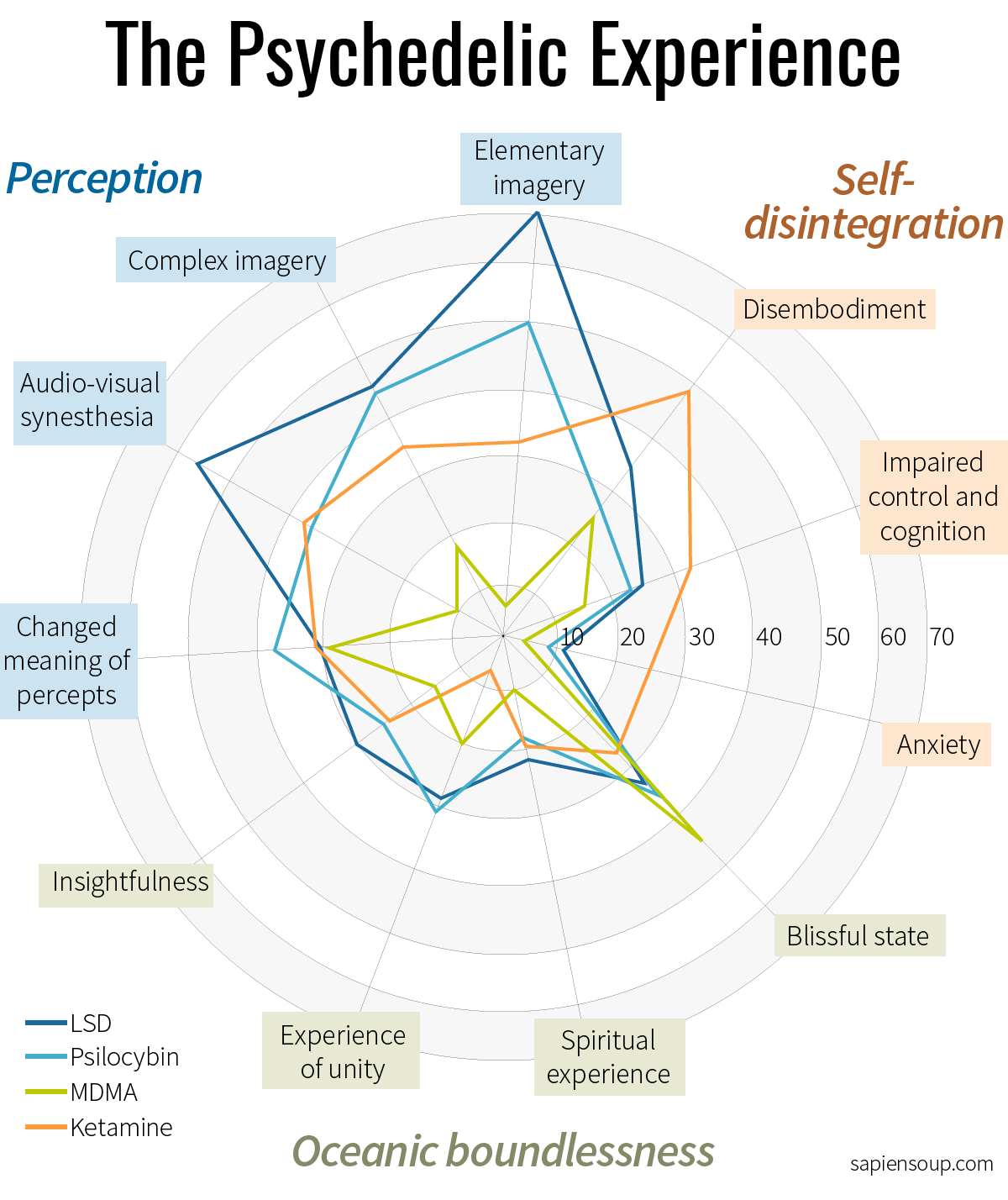 The psychedelic experience according to the 5D-ASC scale.4
The psychedelic experience according to the 5D-ASC scale.4
Just three of the five5 dimensions are displayed above. Let’s take a closer look at what they mean:
1. Perception
Imagery & sound
The degree of hallucinations is dependent on (1) the type of drug and (2) the amount taken. Of the four drugs charted above, MDMA has little potential for producing audiovisual hallucinations, while LSD is the most reliable for creating some sort of changed imagery. The imagery can be elementary: seeing patterns or lights behind closed eyes, or complex: seeing entire scenes behind closed eyes or having an extremely vivid imagination. A different study, using psilocybin, showed that a high dose is twice as likely to produce visual hallucinations than a low dose.6
Changed Meaning
The things you hear and see might change their meaning under the influence of a psychedelic drug. Think of a glass of water: under normal circumstances you might think ‘I drink water when I’m thirsty’. But when consuming a psychedelic substance you might think ’water is the essence of life’. In a recreational drug use context, this change of meaning could make for a few fun stories. In a therapeutic context, however, changing meaning is an important step in order to change thinking and eventually, changing behavior. Think of something that would usually scare you to death, say: spiders. Imagine you took a psychedelic substance and then a spider crawled up next to you. Instead of writhing with disgust, you might think ‘What a peculiar yet fascinating creature’ and pursue its movements with childlike wonder.
Disrupting negative thought patterns is a key element of psychotherapy and can be a lengthy process. Though psychedelic substances present themselves as powerful tools to profoundly and instantaneously change an individual’s perspective, more research has to be done in order to prove their safety.
2. Self-disintegration
Disembodiment & losing control
Who isn’t worried about losing control over their body? This fear is what makes the dimension of self-disintegration so frightening for many of us. It includes feelings of floating, detaching the mind from the body, no longer having a body or one’s own will, having difficulties distinguishing the important from the unimportant or making decisions. Some of that sounds scary, agreed. At the same time, certain practices such as meditation and sensory deprivation tanks aim for creating some of the exact same experiences.
Ketamine scores particularly high in this dimension. LSD, psilocybin and MDMA produce fewer disembodiment experiences.
Anxiety
Note how all four psychedelic drugs score very low on anxiety. That means that even in combination with a possibly daunting out-of-body experience or visual hallucination, users don’t feel anxious about their experience. So-called bad trips more often than not result from a bad choice regarding set and setting, which we’ll discuss in just a moment.
3. Oceanic boundlessness
If the previous section was about the negative side of self-disintegration, this section is about the positive side of it. ‘What’s positive about the disintegration of the self’ you ask? Well, let me ask you in return: do you ever struggle with your self? Most of us experience feelings of anxiety, perfectionism, compulsion, stress, inferiority or guilt. Putting one’s self on hold at times can offer a great deal of relief.
Oceanic boundlessness is a blissful state of contentedness. People experience a deep connection with the world around them. Some describe it as connecting to something “larger” than the self, others talk about having spiritual experiences. LSD and psilocybin score higher than ketamine and MDMA in this dimension. The exception is the blissful state category, where MDMA is ahead by comparison. That makes sense, if you recall how MDMA floods the brain with serotonin, the happiness inducing neurotransmitter.
Different drugs, different experiences
Why do MDMA, LSD, psilocybin and ketamine produce distinctly different experiences? They are all called ‘psychedelics’ because they induce an altered state of consciousness.7 But biochemically, they create their effects by interacting with different elements within the central nervous system.
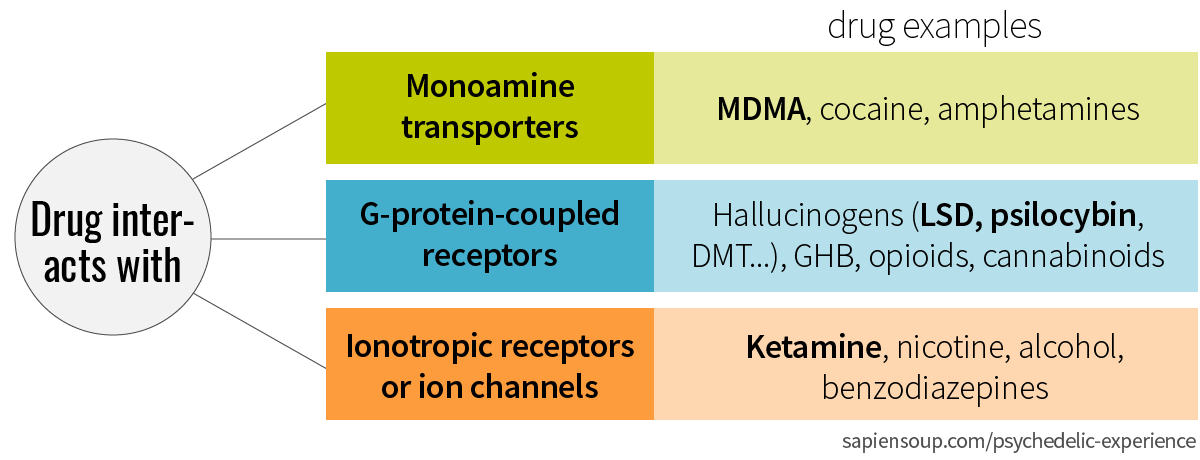 Mechanistic classification of drugs8
Mechanistic classification of drugs8
Within that model, you can further categorize psychedelic drugs according to their subgroups, medical use cases and effects in the brain. MDMA is an empathogen or entactogen, LSD and psilocybin are hallucinogens and ketamine is a dissociative anesthetic.
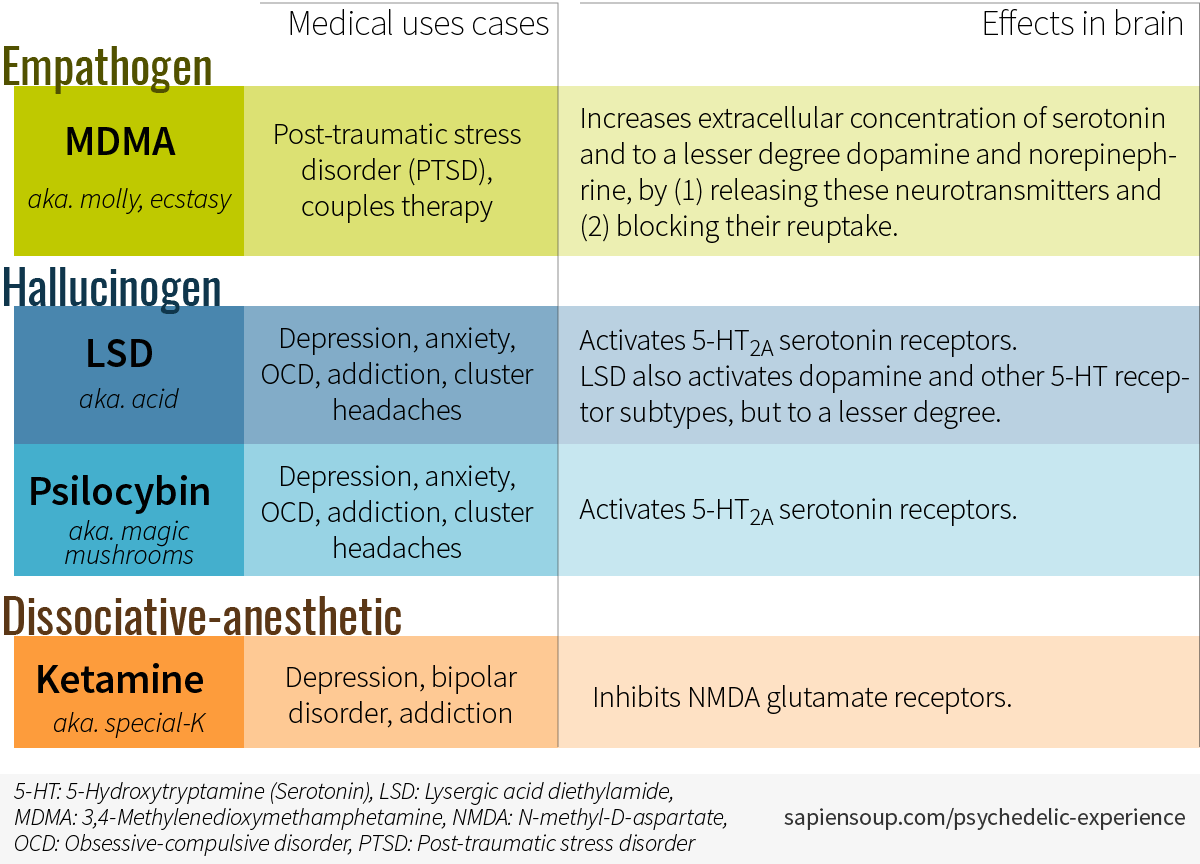
If you struggle to understand the drug’s effects in the brain, read the explanatory primer on the Serotonergic System. With plenty of illustrations and infographics it’ll take you step by step from knowing nothing about neurotransmitters and synaptic receptors to knowing more than most people.
User stories
How does the theory translate into real experiences of real individuals? What follows are some colorfully described user stories.
MDMA
“When ecstasy is coming on it feels fantastically exhilarating. Users report feeling blissed out, energetic, and emotionally opened and loving.”9
How MDMA works in the brain.
LSD
“Ecstatic feelings of love and happiness, affinity for other people, feeling of being at home with one’s self and the universe, flowing visions with more intricacy, beauty, and color than anything found in nature, sound which one can taste and feel with heart and soul, a sense of suspension in time and feeling akin with eternity and infinity, a brilliantly lucid mind able to see itself from vast and novel perspectives, an overwhelming tide of emotions…”9
Psilocybin
Mushrooms produce effects similar to those of LSD but with a different signature. Users frequently describe their experience to be unpredictable and more mysterious. With magic mushrooms “I’ve often felt that I’m in the presence of an ancient teacher, whereas with LSD, it can feel like I’m simply traversing my own mental pathways.”9
Ketamine
Ketamine functions very differently than the other drugs discussed in this series. While most psychedelics interact with the serotonergic system, ketamine interacts with the glutamatergic system. Glutamate is the most abundant neurotransmitter in the brain and plays a vital role in controlling synaptic plasticity, learning and memory10.
Ketamine’s psychoactive effects derive from blocking a certain type of glutamate receptor, specifically the NMDA receptor.11 Being a dissociative anesthetic, the ketamine-induced psychedelic experience has pronounced out-of-body elements including at times even loss of bodily control. At low doses, ketamine puts users in a dreamy, mildly psychedelic state. At high doses, some find it terrifying and some call it “the most intense, bizarre, and enjoyable psychedelic”9. One experienced user described it like this: “As the high is coming on there is a break in the continuity of consciousness. […] Frequently there is no recollection of ever having been myself, been born, had a personality or body, or even known of planet earth. The experience is one of being in total orgasm with the universe. I feel like I’m in hyperspace, simultaneously connected to all things.”9
Bad trips
What about bad trips? Do they exist? Yes, they do. The research team around Roland Griffiths at Johns Hopkins University performed an online survey in which they asked psilocybin users to share details about their worst “bad trip”.
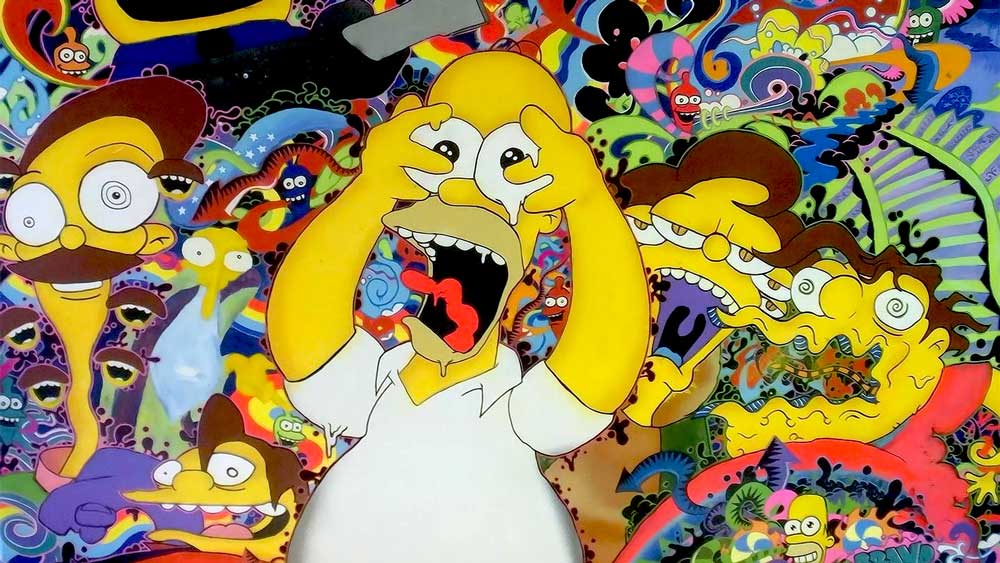 Inspired by Darrik May who used this image for his talk at the Psychedelic Science 2017 conference
Inspired by Darrik May who used this image for his talk at the Psychedelic Science 2017 conference
62 percent of respondents rated their worst bad trip to be amongst the ten most psychologically difficult or challenging experiences of their lives. What’s surprising is that about the same percentage of users also considered it amongst the ten most meaningful experiences of their lives.12 “A difficult experience, sometimes described as catharsis, often results in positive personal meaning or spiritual significance.” says Griffths.13
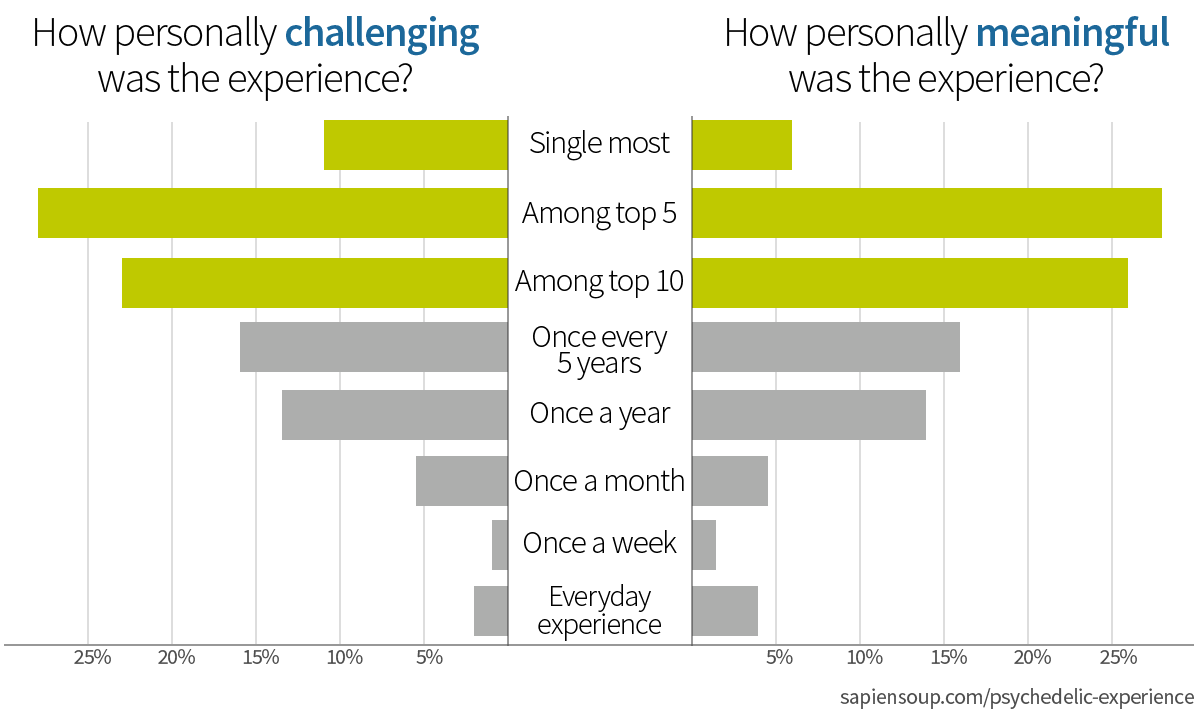 How 2,000 psilocybin users rated their worst bad trip12
How 2,000 psilocybin users rated their worst bad trip12
Challenges may eventually lead to personal growth. 76 percent of participants reported that their difficult experience led to increases in current well-being and life satisfaction.12 This suggests that a “bad trip” might not be so bad after all.
And what triggered these difficult experiences in the first place? Dosage, set and setting were significantly related to the degree of difficulty and duration of the unpleasant experience.
The importance of ‘Set and Setting’
The individual psychedelic experience depends on a number of things. Obviously, it depends on the dose and type of drug the user is consuming. But it also depends on the user’s body composition, gender, genes, their sensitivity to certain drugs or drug interactions with other pharmaceuticals the user is taking, such as contraception or psychiatric meds. And as if all that wasn’t enough variability already, the experience depends greatly on what is called set and setting. Set refers to the individual’s mindset and experience, whereas setting refers to the surrounding and atmosphere.
Taking MDMA during a couples therapy session has entirely different effects than taking MDMA at an electronic dance festival. The psychedelic experience is a function of the mindset as well as the physical and social environment.
The influence of set and setting may explain the staggering variance within early psychedelic research. When LSD was first distributed in the 1950s, it was marketed as a psychosis-inducing drug and was used in clinical psychiatry. Experiments usually took place in highly impersonal surroundings—think stark hospital rooms—and the subjects were often psychiatric in-patients or from socially disadvantaged populations, such as prisoners or drug addicts. In some cases, they had little choice but to participate in these experiments. Now imagine such a subject being tied down to a hospital bed, harsh lighting, rude staff and doctors looking for signs that the administered substance has made the subject become psychotic. Anyone would have a difficult time in such a setting—with or without the drug.
Less than a decade later, LSD became popular amongst college students as a substance that would expand consciousness and enhance creative thinking. Participants joined the studies voluntarily because they were anticipating a meaningful experience. The experiments were often carried out in lovingly furnished rooms with interesting art, flowers and music for the volunteers to enjoy while they waited for the drug to kick in. The researchers would respond to the participant’s personal needs and treat them with kindness and respect.14 Sounds as if someone is about to have a good time—with or without the drug.
Throughout the 1950s and 1960s, various interest groups evaluated LSD’s suitability for serving their particular causes. Those efforts resulted in no less than nine different main conceptions of LSD, among them LSD as a psychotomimetic, a psychotherapeutic tool, a creativity enhancer, a spiritual sacrament, a mind control tool (by the CIA), a battlefield weapon (by the U.S. Chemical Corps), and a revolutionary molecule (by groups such as the Yippies and The Weathermen).14
This all goes to show that set and setting profoundly influence actual psychedelic experiences. Through continued research, however, we’ve been able to pin down a few common denominators of all psychedelic experiences, such as timelessness, selflessness and effortlessness15. In the next story, we’ll look at how these common denominators manifest in the brain. Or to put it another way: what exactly happens in the brain when people lose their sense of time and self?
This was part 3 of our series on psychedelic drugs.
Medical Benefits of Psychedelic Drugs
Psychedelic Drugs and the Serotonergic System
The Psychedelic Experience (You’ve just read it)
Your Brain on Psychedelic Drugs
Psychedelics and Mental Health
Microdosing LSD: Smart Drug or Placebo?
MDMA-assisted Therapy
You can sign up and get notified when we publish our next story.
If you are located in the Vienna area, we invite you to join the Psychedelic Society Vienna meetup, where we’ll discuss the latest research and developments in the field.
References
-
The Mushroom/LSD Experience Explained & Explored Retrieved 2017-06-20. ↩
-
The resource erowid, reports a common dose to be at around 100 micrograms of LSD. LSD Dosage Retrieved 2017-06-20. ↩
-
Dittrich A. The standardized psychometric assessment of altered states of consciousness (ASCs) in humans. Pharmacopsychiatry. 1998 Jul;31 Suppl 2:80-4. Review. PubMed PMID: 9754838 ↩
-
Some titles were modified for better understanding. Data from Studerus E, Gamma A, Vollenweider FX. Psychometric Evaluation of the Altered States of Consciousness Rating Scale (OAV). Bell V, ed. PLoS ONE. 2010;5(8):e12412. PMCID: PMC2930851 and Carhart-Harris RL, Muthukumaraswamy S, Roseman L. Neural correlates of the LSD experience revealed by multimodal neuroimaging. Proc Natl Acad Sci U S A. 2016 Apr 26;113(17):4853-8. PubMed PMID: 27071089 ↩ ↩2
-
What’s not displayed in the chart are the two remaining dimensions acoustic alterations and altered vigilance. ↩
-
Vollenweider FX, Kometer M. The neurobiology of psychedelic drugs: implications for the treatment of mood disorders. Nat Rev Neurosci. 2010 Sep;11(9):642-51. Epub 2010 Aug 18. Review. PubMed PMID: 20717121. ↩
-
Psychedelic drug. Wikipedia. Retrieved 2017-06-20 ↩
-
Lüscher C, Ungless MA. The Mechanistic Classification of Addictive Drugs. PLoS Medicine. 2006;3(11):e437. PMCID: PMC1635740 ↩
-
Turner DM. 1994. The Essential Psychedelic Guide. Panther Press ↩ ↩2 ↩3 ↩4 ↩5
-
NMDA receptor. Wikipedia. Retrieved 2017-06-20 ↩
-
Bear M, Connors BW, Paradiso MA. Neuroscience. Exploring the Brain. 4th edition. Wolters Kluwer. ↩
-
Carbonaro TM, Bradstreet MP, Barrett FS et al. Survey study of challenging experiences after ingesting psilocybin mushrooms: Acute and enduring positive and negative consequences. J Psychopharmacol. 2016 Dec;30(12):1268-1278. Epub 2016 Aug 30. PubMed PMID: 27578767. ↩ ↩2 ↩3
-
McMains V quotes Griffiths RR. 2017. Study explores the enduring positive, negative consequences of ingesting ‘magic mushrooms’ on HUB. Retrieved 2017-06-14 ↩
-
Hartogsohn I. The American Trip: Set, Setting, and Psychedelics in 20th Century Psychology. MAPS Bulletin Special Edition. Spring 2013. Retrieved 2017-06-07 ↩ ↩2
-
Strongly recommended read: Kotler S, Wheal J. 2017. Stealing Fire. Dey Street Books. ↩
